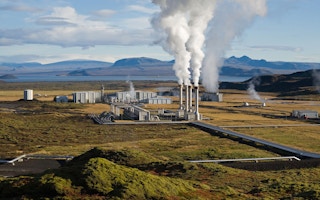More than a century ago an Italian prince developed a machine that harnessed the hot air rising from the hills south of Florence to spin a turbine and generate the world’s first geothermal power.
Today the region better known for Chianti wine than high-technology produces enough power for a million people. That’s helped make Italy Europe’s biggest generator from underground heat, the world’s cheapest source of electricity.
Enel Green Power SpA, which operates the plant, says its experience will give the unit of Italy’s largest utility an edge as it spends 900 million euros ($1.2 billion) in four years to take its technology from Turkey to Peru. Researcher Frost & Sullivan Inc. expects the global market to grow fivefold to $5.89 billion in the seven years through 2017 as governments cut green subsidies and seek alternatives to wind and solar.
“A lot of people can do solar or wind, but geothermal is quite complex,” Enel Green Power Chief Executive Officer Francesco Starace said in an interview. “The fact that we’re already ahead of others is an advantage. It’s a good hedge against risks for us.”
The most common form of geothermal power costs about $64.20 a megawatt-hour, according to Bloomberg New Energy Finance, below the $78.30 for coal, $82.61 for onshore wind turbines and $142.68 for traditional solar panels.
Worldwide geothermal capacity will probably double by 2030, with the pace of growth accelerating after 2020 as government policies change to promote investment, according to a New Energy Finance report in June. The rising price of electricity and the low cost of geothermal compared with other renewables will make it increasingly attractive, BNEF said.
‘Least-cost option’
“In numerous countries across Latin America, East Asia, Southeast Asia, geothermal is not just an option for renewable power but is the least-cost option for power generally, better than coal, gas and hydro,” Mark Taylor, one of the authors, said by e-mail. “If a country has plentiful and powerful geo resources, geo will be highly competitive with all power and generally represent a growth opportunity.”
Globally, 13.2 gigawatts of geothermal projects are in the pipeline, with Israeli developer Ormat Industries Ltd. leading the way, followed by France’s GDF Suez SA and Supreme Energy of Indonesia, according to BNEF.
“Enel has a long history in geopower,” Taylor said. “As a company with experience and available capital, Enel is competitive.”
In the U.S., Enel Green Power is installing a further 25 megawatts at its plant in Cove Forth,Utah, as part of its 600 million-euro overseas investment strategy. The company plans to expand in Turkey, where it has 142 licenses to explore with local partner Uzun Group as part of a government push to install 600 megawatts of capacity by 2015.
Chile potential
Other ventures abroad include El Salvador, Peru, Guatemala and Chile, where Enel Green Power was awarded three exploration licenses totaling 165,702 hectares last year.
Chile has the world’s greatest unexploited geothermal potential, according to a February BNEF report, with an estimated 16-gigawatt resource yet to be tapped.
Enel Green Power is investing 900 million euros in geothermal over the next four years as part of 6.1 billion euros in total capital expenditure.
In Italy, the company will spend 300 million euros, including a new 40-megawatt plant in Devil’s Valley south of Florence, which will start producing power next year, according to Roberto Parri, head of Enel Green Power’s operations in the area. There’s potential to boost installed capacity by roughly 100 megawatts in the next 10 years, Parri said.
Prince Conti
Italy, which generates 5,520 gigawatt-hours a year, ranks fifth among geothermal producers after the U.S., Philippines, Indonesia and Mexico, according to the International Energy Agency. Until the 1950s, when New Zealand built its first plant, it was the only geothermal generator in the world.
In 1904 Prince Piero Ginori Conti used his machine to generate enough power from the hot air at Devil’s Valley to illuminate five light bulbs. The first plant was built in Larderello in 1913, and by 1916 installed capacity was 9 megawatts.
Today, 311 miles (500 kilometers) of shiny aluminum tubes crisscross the green countryside between Pisa and Siena distributing energy equal to 3.1 million tons of oil equivalent a year and providing electricity to one in four Tuscan homes.
Alessandro Giannetti, the mayor of Monterotondo Marittimo near Larderello, said the town counts on the plant for household heat, power and jobs. He recalls his grandmother holding chickens over the geysers to strip them of their feathers, and tomatoes to remove the skins.
“We’ve always used the earth’s energy,” he said.

















